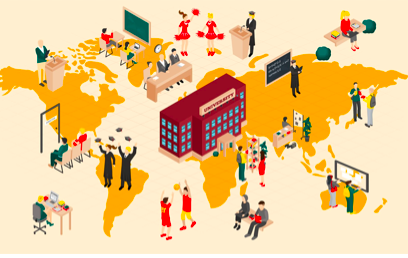Why You Should Shop Secondhand
Yes, you read that correctly. It might seem strange to suggest secondhand shopping to those whose families can afford a high tuition school such as Friends Academy and therefore whatever they may want when it comes to clothing. If you have this freedom to choose, why don’t choose the wonders of secondhand shopping? Our society has highly stigmatized secondhand shopping, more commonly called “thrifting”, as a symbol of financial struggle and the inability to afford the “real deal” when it comes to clothing. Not only is this stigma degrading for those who do in fact rely on thrift and consignment stores to fill their closet, but it’s additionally limiting the many amazing perks that come along with shopping second hand!
- The Environment!
Common stores for clothes shopping like Brandy Melville, Forever 21, H&M, and practically all others are part of the “fast fashion” system. Investopedia defines fast fashion as “clothing designs that move quickly from the catwalk to stores to meet new trends. The collections are often based on designs presented at Fashion Week events. Fast fashion allows mainstream consumers to purchase trendy clothing at an affordable price.” This revolving door of responding to current trends leads to excessive amounts of waste when the next style comes around. These clothes end up filling our landfills, and use up extreme amounts of water and other resources needed to produce new clothing (Sustain Your Style). While there’s the benefit to your own sense of morality that you’re not purchasing and wearing clothes that can harm our planet, there’s also the benefit of reducing the demand for fast fashion production. The fewer people purchasing directly from these fast fashion manufacturers, the less they need to produce and therefore fewer natural resources they use up and greenhouse gases they pump out. Plus, by wearing thrifted clothes, you’re giving these items a new life and keeping that item out of our oceans and landfills!
- Easier to Curate Your Own Style
As aforementioned, common clothing stores are extremely responsive to what’s currently trendy this season, month, or even week. While it’s fun to keep up with the current style, it can also feel constraining and boring to find yourself wearing the same things as the people around you. When thrifting or going to consignment shops, you get to find your own unique pieces to comprise your style. If you still want to be on trend though, have no fear. The correlation between secondhand fashion and current trends is currently stronger than ever! Check out fellow Inkwell author Emma Herold’s piece about the intersection of current trends and secondhand shopping to see how easy it is to stay on trend while shopping secondhand.
- Human Labor Impact
Do you know how your clothes are made? Do you know who makes them? The majority of the fast fashion industry that is distributed in America is actually produced overseas, primarily in developing or under-developed nations. While in the U.S. there are relatively strict labor laws in place, this is not the case in other nations where our clothes are primarily produced. Garment workers are often underpaid and forced to work in extremely cramped and dangerous conditions. If you’ve learned about the Triangle Shirtwaist Factory fire of 1911 in APUSH or other history classes, you know how dangerous an unregulated factory can become. Although similar incidents have not been repeated in the U.S. due to strict labor and health laws, many of which stemmed from this tragedy, this is not the case for other clothing manufacturing hubs around the world. A great documentary to learn more about the human impact of fast fashion is “The True Cost” by filmmaker Andrew Morgan.
- Cheaper!
While there is a growing market of ethical fashion produced in more sustainable ways, this new wave of “slow fashion” can be extremely pricey due to the amount of extra effort and time it takes to produce. At the same time, even if you can afford fast fashion easily, being frugal with your savings never hurt anybody! Although consignment shop prices can easily climb, thrift stores and online second-hand shopping sites are often the most cost friendly ways to shop. Prices tend to range from $1.99 at stores like Savers, Goodwill, and MyUnique and reach $19.99 max on expensive designer items. It’s a great way to get tons of items for cheap!
Besides the aforementioned reasons, there are SO many more benefits of second hand shopping, like the social experience of going with friends. Some of my favorite items I’ve thrifted were actually found by friends I went shopping with! It’s so fun to see what crazy things you may find, as well as pieces you might not have thought to buy for yourself but end up loving. Plus, it’s a great way right now to be able to hang out socially distant. On the subject of COVID-19, there’s likely to be lingering concerns on safety of in-person thrifting right now. Have no fear though for the majority of thrift stores will wash and/or sanitize their items when they receive them. Additionally, COVID-19 is transmitted through water droplets which do not remain active and infectious on clothing surfaces. As long as you wear your mask and follow the shop’s social distancing guidelines, thrifting is just as safe as, if not more than, any other public outing right now.
Even with all these benefits, nobody’s perfect! Don’t feel like you have to make a complete closet conversion to make a difference. A great place to start is online thrifting on apps like Depop and Poshmark because you can easily narrow your search to what you’re currently comfortable wearing. As you get more comfortable, set aside a few hours on a weekend with a low homework load and try heading to thrift stores in person. Remember, it’s better to start small than not start at all. Thrifting is more than just a great way to get new clothes, it’s one of the easiest ways to be a true global citizen. Do your part and turn your closet into a work of art!











